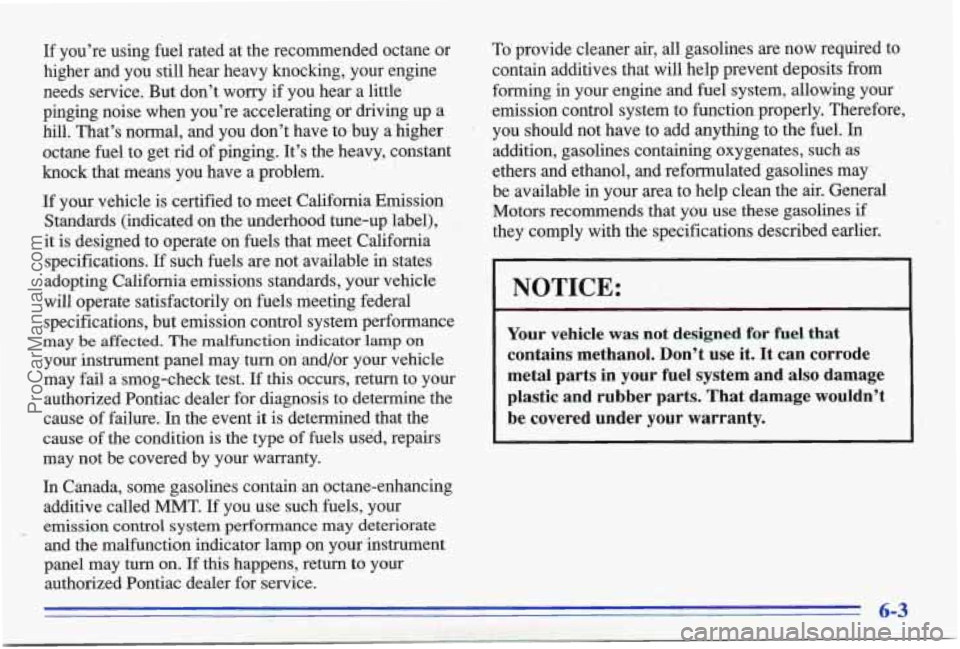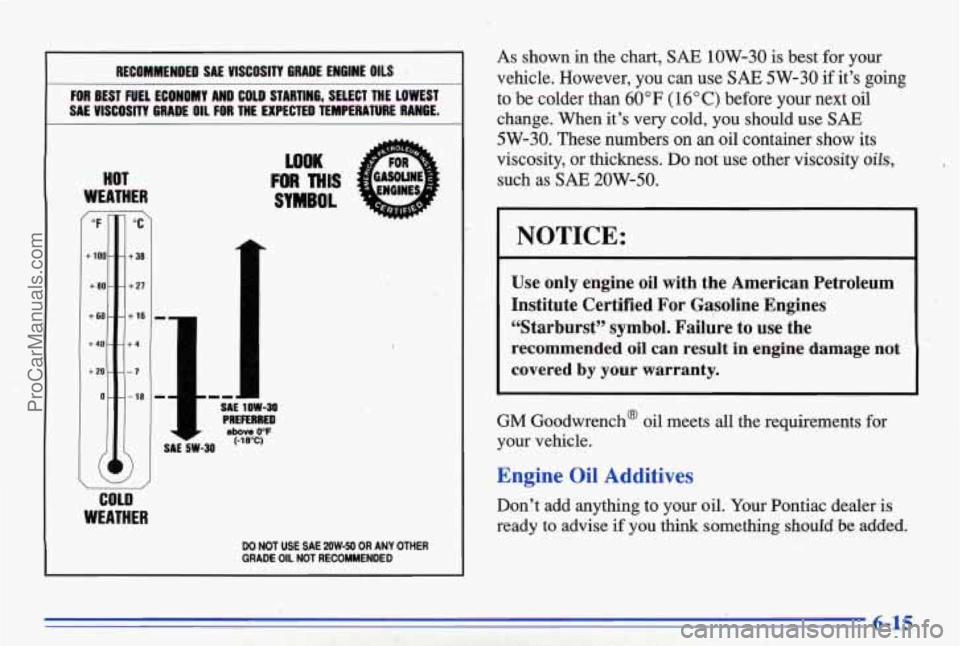fuel additives PONTIAC BONNEVILLE 1996 Owners Manual
[x] Cancel search | Manufacturer: PONTIAC, Model Year: 1996, Model line: BONNEVILLE, Model: PONTIAC BONNEVILLE 1996Pages: 387, PDF Size: 18.71 MB
Page 248 of 387

If you’re using fuel rated at the recommended octane or
higher and you stiil hear heavy knocking, your engine
needs service. But don’t worry
if you hear a little
pinging noise when you’re accelerating or driving up
a
hill. That’s normal, and you don’t have to buy a higher \
octane fuel to get rid of pinging. It’s the heavy, constant
knock that means you have a problem.
If your vehicle is certified to meet California Emission
Standards (indicated on the underhood tune-up ’label),
it is designed to operate on fuels that meet California
specifications.
If such fuels are not available in states
adopting California emissions standards, your vehicle
will operate satisfactorily on fuels meeting federal
specifications, but emission control system performance
may be eected. The malfunction indicator lamp on
your instrument panel may turn on and/or-your vehicle may fail a smog-check test.
If this occurs, return to your
authorized Pontiac dealer for diagnosis to determine the
cause of failure.
In the event it is determined that the
cause
of the condition is the type of fuels used, repairs
may not be covered by your warranty.
In Canada, some gasolines contain an octane-enhancing
additive called MMT.
If you use such fuels, your
, emission control system performance may deteriorate
and the malfunction indicator lamp on your instrument
panel may turn on.
If this happens, return to your
authorized Pontiac dealer for service.
To provide cleaner air, all gasolines are now required to
contain additives that will help prevent deposits from
forming in your engine and fuel system, allowing your
emission control system to function properly. Therefore,
you should not have to add anything
to the fuel. In
addition, gasolines containing oxygenates, such as
ethers and ethanol, and reformulated gasolines may
be available in your area to help clean the air. General
Motors recommends that you use these gasolines
if
they mcomply with the specifications described earlier.
NOTICE:
Your vehicle was not designed for fuel that
contains methanol. Don’t use it. It can corrode
metal parts in your fuel system and also damage
plastic and rubber parts. That damage
wouldn’t
be covered under your warranty.
ProCarManuals.com
Page 260 of 387

I RECOMMENDED SAE VISCOSITY GRADE ENGINE OILS 1
FOR BEST FUEL ECONOMY AND COLD STARTING, SELECT THE LOWEST
I SAE VISCOSITY GRADE OIL FOR THE EXPECTED TEMPERATURE RANGE.
HOT
WEATHER
/
COLD
I WEATHER
SAE 5W-30
WOK
FOR THIS 4
SYMBOL
SAE 10W-30 PREFEMEO abow (PF (-18°C)
DO NOT USE SAE MW-50 OR ANY OTHER GRADE OIL NOT RECOMMENDED
As shown.in the chart, SAE 1OW-30 is best for your
vehicle. However,
you can use SAE 5W-30 if it’s going
to be colder than 60 OF (1 6 O C) before your next oil
change. When it’s very cold, you should use
SAE
5W-30. These numbers on an oil container show its
viscosity, or thickness. Do not use other viscosity
oils,
such as SAE 20W-50.
NOTICE:
Use only engine oil with the American Petroleum
Institute Certified For Gasoline Engines
“Starburst” symbol. Failure to use the
recommended oil can result in engine damage
not
covered by your warranty.
GM Goodwrench@ oil meets all the requirements for
your vehicle.
Engine Oil Additives
Don’t add anything to your oil. Your Pontiac dealer is
ready to advise if you
think something should be added.
6-15
ProCarManuals.com